24-25 Octonber 2009
Saturday 25th Attendance: 2 Today got off to a awkward start as Jason arrived to find that Adam was already there and waiting to get into the support coach but he didn't have a coach key, however Jason was in his dads car and had left his own coach key 120 miles away in his own car back at home, so they had to go around and ask the other people on site if they could borrow a coach key but it took over 20 mins until they managed to find someone who had one they could borrow and finally get into the coach. As it was only two people around today we had to think what we were going to do, Adam had plans to continue with the remaining drelling & painting around the cooler group and engine room walls but started the day off by removing the cab bulkhead door between the cab & the cooler group this was so that he could get at the area behind it and start work on preparing the door frame itself. The door was unbolted and taken into the workshop of the support coach where it could be better worked on. Jason on the other hand was concerned about the state the inside of the loco was getting into, what with drelling dust all over the previously painted cooler group & engine room floor lots of discarded PPE, masks, gloves and goggles note to mention tools lying around here and there and everywhere, so Jason took it upon himself to have a massive tidy up starting with the engine compartment. All the tools & PPE equipment were collected and a pile of pipes that were on the L/H side of the floor were moved over to the R/H side. He then set about sweeping up the dust into piles then using the vacuum cleaner to pick it all up. Adam meanwhile was set up in the cooler group and was drelling down the inner lower section of the L/H radiator scoop, once that was done he moved onto the wall section around the air intake grille just behind the L/H scoop and as the paintwork here was not too bad he used the orbital sander to key the surface down ready for a new application of gloss by which time Jason had finished vacuuming the floor and had now decided to move down the loco as beyond the bulk head that separates the engine room from the clean air compartment where the generator, train heat boiler & brake frame is, this area has been a dumping ground for all the other large pipes from the engine room and old blue tarp that used to cover the loco, this was in a large mound on the R/H side of the floor by the boiler mount, but now it was time to sort this mess out. First he had to clear the way by picking up the engine air intake manifold that was laid on the floor where the generator should be that was picked up and leant up against the L/H wall behind the central bulkhead door, which exposed the main generator conduit box in the floor, there was a lot of loose conduit off cuts stood up in the conduit trough nearby these were relocated to the conduit box temporarily. Jason then moved all the foam insulation sheets into the cubical compartment and the sheets of pegboard over to the L/H wall of the engine room, this made space to start sorting out the mound. Adam had now applied the white undercoat to the areas he had been drelling and now drelled down the top surface of the TMB mounting box in the cooler group and slapped un some green primer once he was done, after which he turned his attention to the door frame of the cab bulkhead door. By now Jason was pulling the mound apart, all the pipes were placed in a pile on top of the walkway down the L/H side while the blue trap was slowly untangled, once the pipes had been sorted out it was time to remove the tarp, so Jason unlocked the No2 end L/H cab side door and began to pull the old blue tarp out of the door, Adam had to provide some assistance in feeding the tarp to the door while Jason was outside pulling it through, eventually it was all out of the loco and Jason & Adam went over into the empty car park space and proceeded to fold the tarp up, not an easy task as the wind was blowing quite a bit but eventually they managed to get it folded up and it was then put into the Co-Bo engine tent out of the way. Removing the tarp had exposed a few items like a Master controller unit (removed from the No2 end cab) this was relocated into a small cubby hole out the way, also there were was a pair of bearing shells along with the mounting cap, the shells had been re-mettaled but not machined, Jason recognised these as main crankshaft bearings from the Crossley HSTV8, one of the reasons the engine had been stopped was that one of the bearings had picked up, this is probably that bearing and signs are that an attempt had been made to fix it but it was unfinished, so Jason decided to put the bearing and cab in safe place in the R/H side radiator air scoop tub, some other things that came out of the mound were the engine charge air manifold ends these they decided to move down to the tent but as they were a bit heavy a wheel barrow was used to transport them. The sorting out of the mound has cleared a huge space in the boiler compartment, it has also exposed the brake frame most of which is still in situ, this is a job for another time as Jason needed to move the remaining pipes from the engine room floor down to the boiler end where they can be stored until we are ready to process them, this bought to an end the days work and for once we had something substantial to show for out efforts but Adam had noted we were running out of walls to paint in the engine compartment and that one of the walls was missing, so a plan was hatched to do something about it but that would have to wait till tomorrow. Sunday 26 th Attendance: 2 Sunday dawned and after a trip down to Greggs for breakfast Adam was keen to get started, he set up the needle gun and was gunning down the inside of the air intake grille on the L/H side of the loco just behind the cooler group, Jason meanwhile had planned to retrieve the bulkhead plates for the wall that separates the Engine room from the clean air compartment, so after Adam had finished gunning the grille they went down to Castlecroft in the estate car Jason was in and went into the main shed at Castlecroft and dug out the two bulkhead plates and the two doors there that were thought to be the bulkhead side doors, on taking the stuff back to the loco Jason & Adam set about putting the bulkhead back up temporarily using a couple of fresh bolts, the top section over the generator went in ok but the upper section with the hole for exhaust pipes to pass through was being awkward, it had to be flexed so that it would fit into the channel mountings at either side and with a little effort it went in, now it was time to fit the side doors, but soon Jason encountered a couple of problems. First of which was the gap between the middle & upper centre bulkhead plates, they mounted to opposite ends of the channel mounts at the cantrail level, and it soon became obvious that a channel beam was needed to pass between and bolt the two plates to, the other problem was the side doors, the hinges were not quite right, even through all the doors on the loco are made from the same basic cast aluminium unit there are subtle differences, one had square hole in the bottom covered with a metal sheet, it soon became obvious that these doors were for the No2 end Cab & electrical cubical at the other end of the loco so Jason removed them and fitted then to their correct position, but this meant he had to take a 2 nd trip to Castlecroft to find the other doors, meanwhile Adam was applying the gloss paint to the area around the L/H side of the cooler group that he'd primed & undercoated before. While at Castlecroft Jason managed to locate the other doors and also found some plates that looked like they would fit the missing inspection hatches in the cooler group air scoops so he bought them back as well as the channel beam for the divider bulkhead On return he tried the other two doors in the bulkhead and they fitted a lot better, the channel was stowed for another time, something else that Jason had retrieved from “Co-Bo world” was the base plate and coolant feed manifold that fits to the bottom of the Coolant header tank in the roof, this is all painted up ready to go and Adam & Jason test fitted to the studs on the bottom of the tank to make sure it fitted correctly and it did. However there is still work to be done to the header tank so it was again removed and stowed away until its needed,. Adams next task was to gloss paint the engine air intake box and as it take up nearly all the R/H side wall of the engine bay it took him most of the afternoon to complete, Jason meanwhile applied some of the rust killer gel to the back side of the Air intake grille next to the Cooler group on the L/H side and by this time it was getting late in the day and after packing up all the tools they retired to the support coach where Adam applied the 2 nd coat of black paint to the good set of radiator tanks & side frames, so ended another working weekend on the sole surviving Metrovick Type 2
|
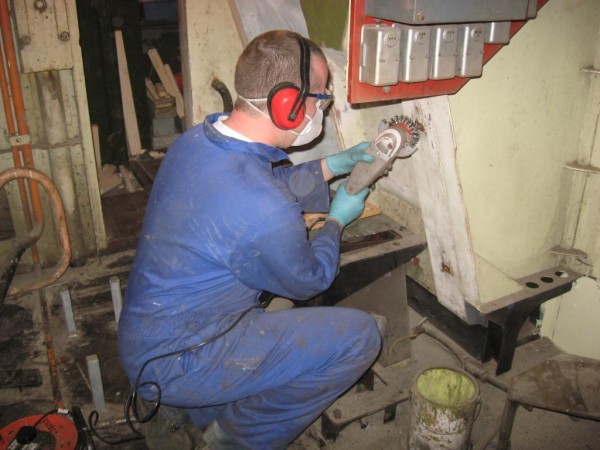 |
| Above : Adam drells the remainder of the inner panelling on the L/H Radiator air scoop. © C15PS |
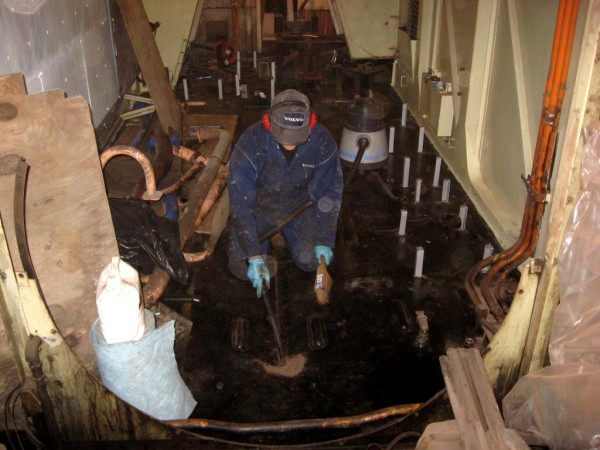 |
| Above : After sweeping the dust into a pile Jason uses the Vacuum to suck it up. © C15PS |
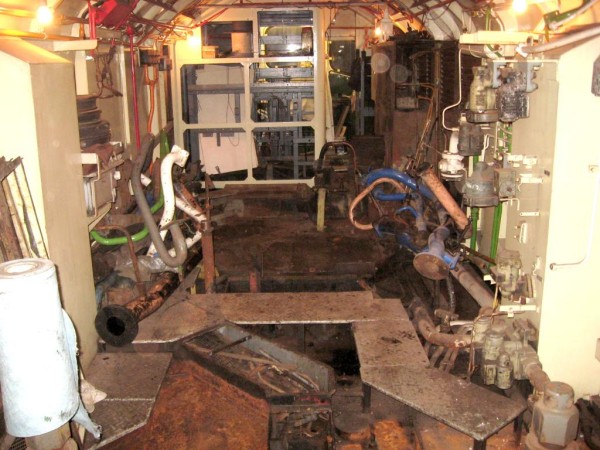 |
| Above : It took all day to sort it out but the Boiler compartment is much tidier now. © C15PS |
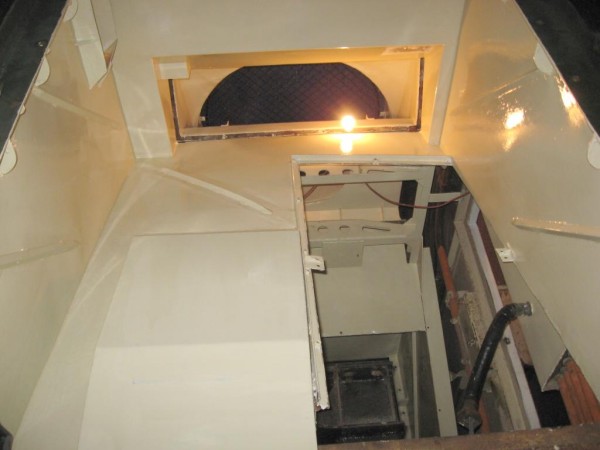 |
| Above : Painting in the inside of the L/H Radiator air scoop is nearly completed. © C15PS |
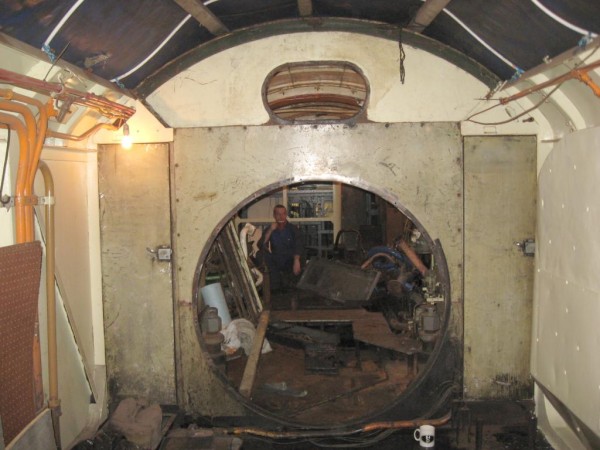 |
Above : The missing Bulkhead plates were found and test fitted back into place. © C15PS |
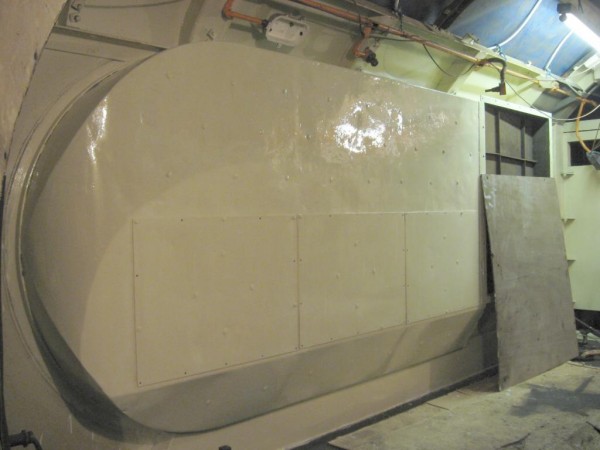 |
| Above : The Engine air intake box was glossed with the last of our original hemp paint. © C15PS |
Fancy Getting Involved? click on the You Can Help page